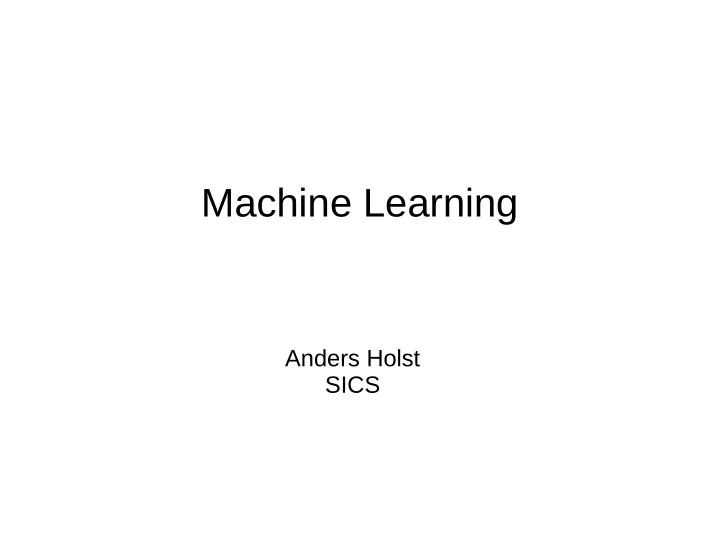

Machine Learning Anders Holst SICS
Big Data Analytics Analysis Big Data Big Value
Big Data Analytics Analysis Big Data Big Value Real world Question Data Model Conclusion
Machine Learning Use real data to train a model, which can then be used to solve various tasks.
Machine Learning Use real data to train a model, which can then be used to solve various tasks. Tasks: ● Classification ● Clustering ● Prediction ● Anomaly detection
Machine Learning Use real data to train a model, which can then be used to solve various tasks. Tasks: Applications: ● Classification ● Medical diagnosis ● Clustering ● Computer vision ● Prediction ● Speech recognition ● Anomaly detection ● Fraud detection ● Recommender systems ● Sales prediction
Machine Learning Input features Output value X 2 ? X 1
Machine Learning Input features Output value Data types: ● Binary or discrete ● Continuous values ● Time series ● Natural language text ● Images ● Sound
Machine Learning Methods ● Case based methods Table lookup, Nearest neighbour, k-Nearest neighbour ● Logical Inference Inductive logic, Decision trees, Rule based systems ● Artificial Neural Networks Multilayer perceptrons, Self Organizing Maps, Bolzmann machines, Deep neural networks ● Statistical methods Naive Bayes, Mixture models, Hidden Markov models, Bayesian networks, MCMC, Kernel density estimators, Particle filters ● Heuristic search Genetic algorithms, Reinforcement learning, Simulated annealing, Minimum Description Length
Case based methods ● ”Similar patterns belong to the same class” ● Easy to train (just save every ? pattern), but takes longer during recall, to find the similar patterns ● Model size increases with the number of seen examples ● Requires specification of a distance measure
Logical Inference ● Construct logical expressions that characterizes the classes ● Typically considers one ? feature at a time – axis parallell decision regions ● A decision tree be constructed using e.g. information theory X1>3.5 X2>1.8
Artificial Neural Networks ● Inspired by the neural structure of the brain ● Neural units connected by ? weights. Weights are adjusted to produce the best mapping. ● ”Deep” architectures has gained popularity – requires much data to train Wjk Wij
Statistical methods ● Large number of methods, from simple to complex ● The common idea is to calculate ? the probability of each class given a feature vector, P(c| x ) ● Parametric versus nonparametric methods – depending on whether the forms of the class distributions are known or not
Logical Neural Statistical Case- Inference Networks Methods based
Representation Logical Neural Statistical Case- Inference Networks Methods based
Representation ● The exact choice of method is often not critical, but the choise of representation of features is: – With the wrong representation no method will succeed – Once you have found a good representation, almost any method will do ● Once preprocessing has turned data into something reasonable, a simple model may be sufficient – With limited amount of independent data, the number of parameters must be kept low, so keep it as simple as possible ● Finding a suitable representation requires much domain knowledge and problem understanding – No black box solution in general
Neural Network book, 1969
Data cleaning Representation Logical Neural Statistical Case- Inference Networks Methods based
Data cleaning Real data is not clean: ● Missing data ● Out of sync fields ● Misspellings ● Special values (temperature -9999) ● Spikes (10e+14) ● Dirty or drifting sensors (0.3 – 100.3 %) ● Data from different sources (old / new), with slightly different meaning ● Inconsistent data ● Irrelevant data
Data cleaning Attr 1 Attr 2 Attr3 Attr 4 Attr 5 12.2827 2002080612220500 10.47 5.2 Cool. on 12.2826 2002080612220622 15.39 4.7 Switch 12.2825 2002080612220743 12.66 5.9 hasp temp 680 12.2824 2002080612220886 -999.0 22.8 Hasp-temp 1.22823 2002080612221012 -999.0 Overflow cool 12.2819 2002080612221136 -999.0 Overflow Cooling 12.2815 1858111700000000 13.49 Error cooling on 122821 1858111700000000 25.85 Error sw. 12.2823 2002080612221631 22.98 0.6 not in phase ... ... ... ... ...
Data cleaning Representation Logical Neural Statistical Case- Inference Networks Methods based Validation
Validation ● “Validation” is used to estimate the performance on new data, i.e. how the model would perform when actually used ● To get good generalization you must avoid overtraining the machine learning model ● There are unimaginably many ways that makes the result look better in the laboratory than in the real life ● However hard you try to avoid it, you will always get too optimistic validation results!
Validation Some ways to guarantee overtraining: ● Too few data samples ● Too complicated model ● Too similar training, test and validation samples ● Fine-tuning your parameters ● Evaluating several models with the same validation set
Data cleaning Representation Logical Neural Statistical Case- Inference Networks Methods based Validation Deployment
Deployment ● The method is on its own ● Keep it simple and robust ● Must the network be regularly retrained? Can the “ground truth” be trusted? Can stability and performance be guaranteed? ● Did your pre-study test the right thing? Distinction between prediction and control Distinction between prediction and causation ● Be prepared to go all over the process again
Data cleaning Representation Logical Neural Statistical Case- Inference Networks Methods based Validation Deployment
Conclusions ● Thoroughly understand the problem you are working on and try to understand the process that generated the data ● Select a suitable representation, of the relevant features ● Take extreme care with validation, and test the application on as much real-world data as you can ● Keep it as simple as possible (but still powerful enough to solve the problem at hand).
Recommend
More recommend